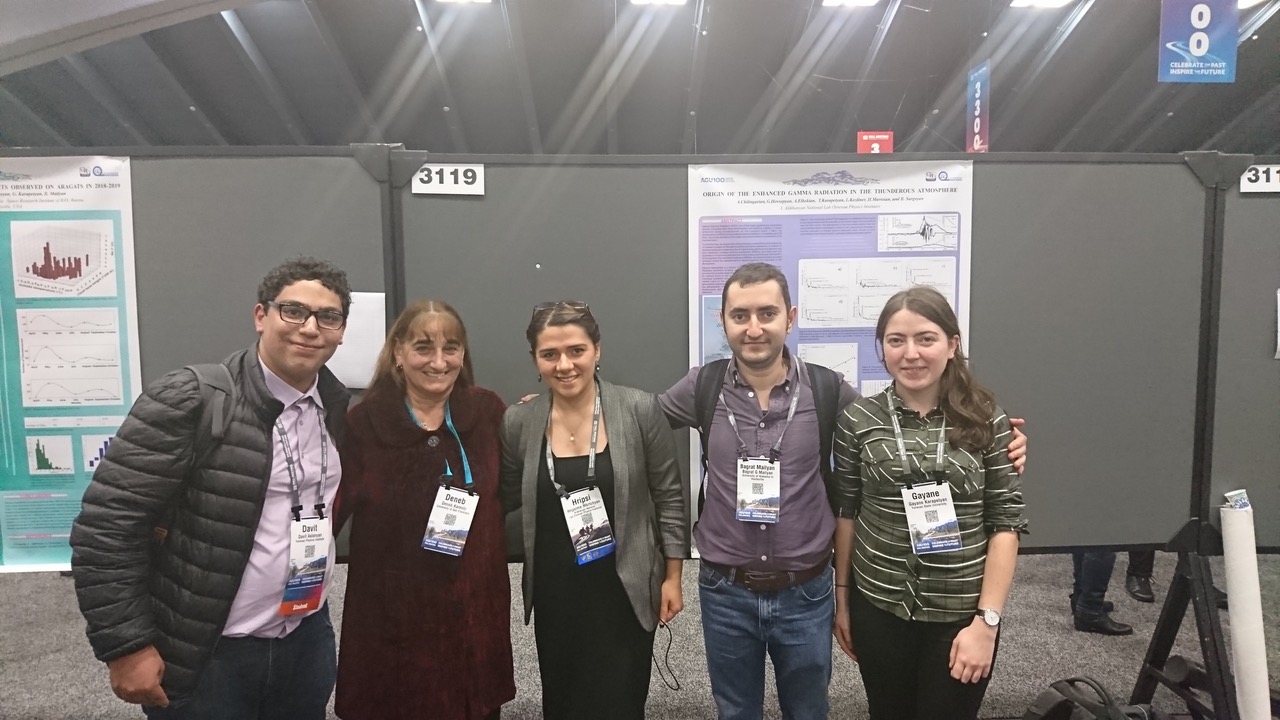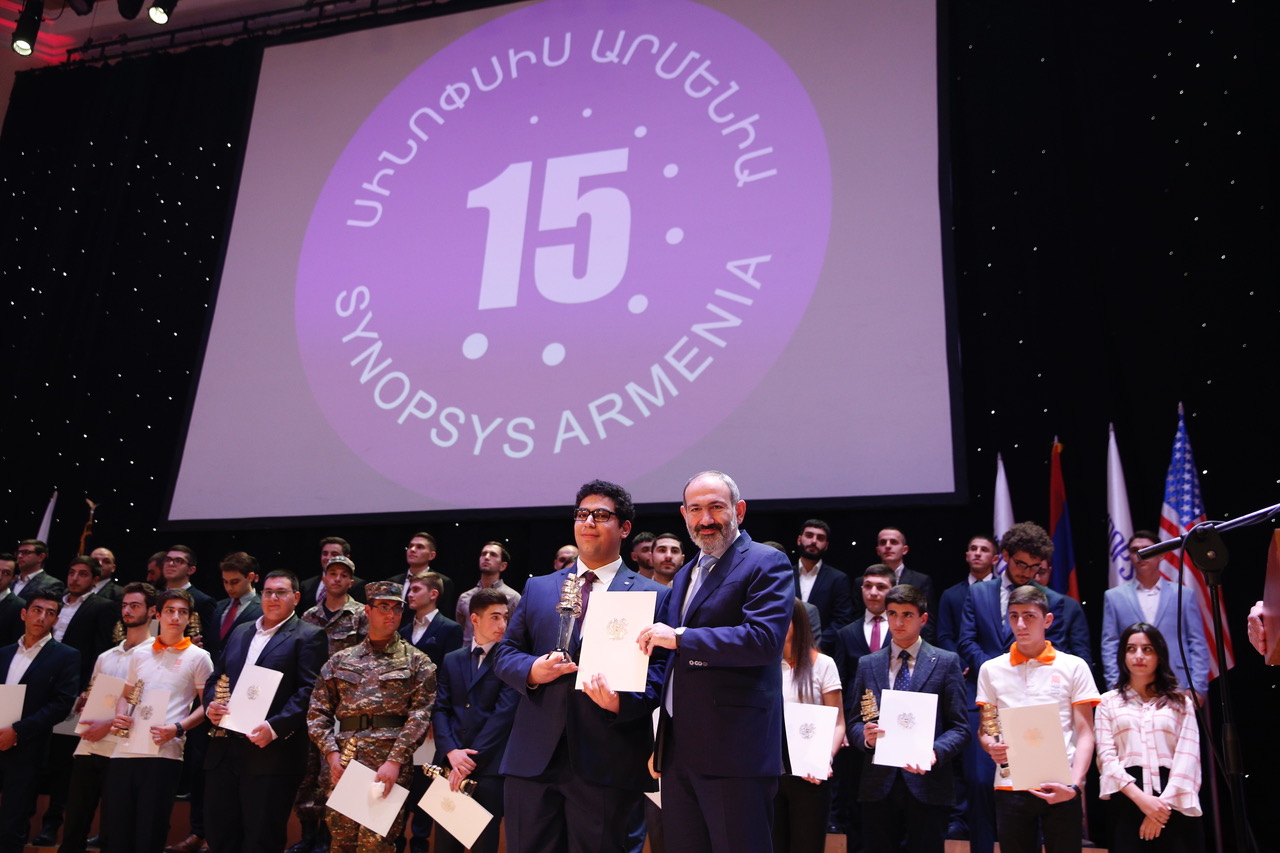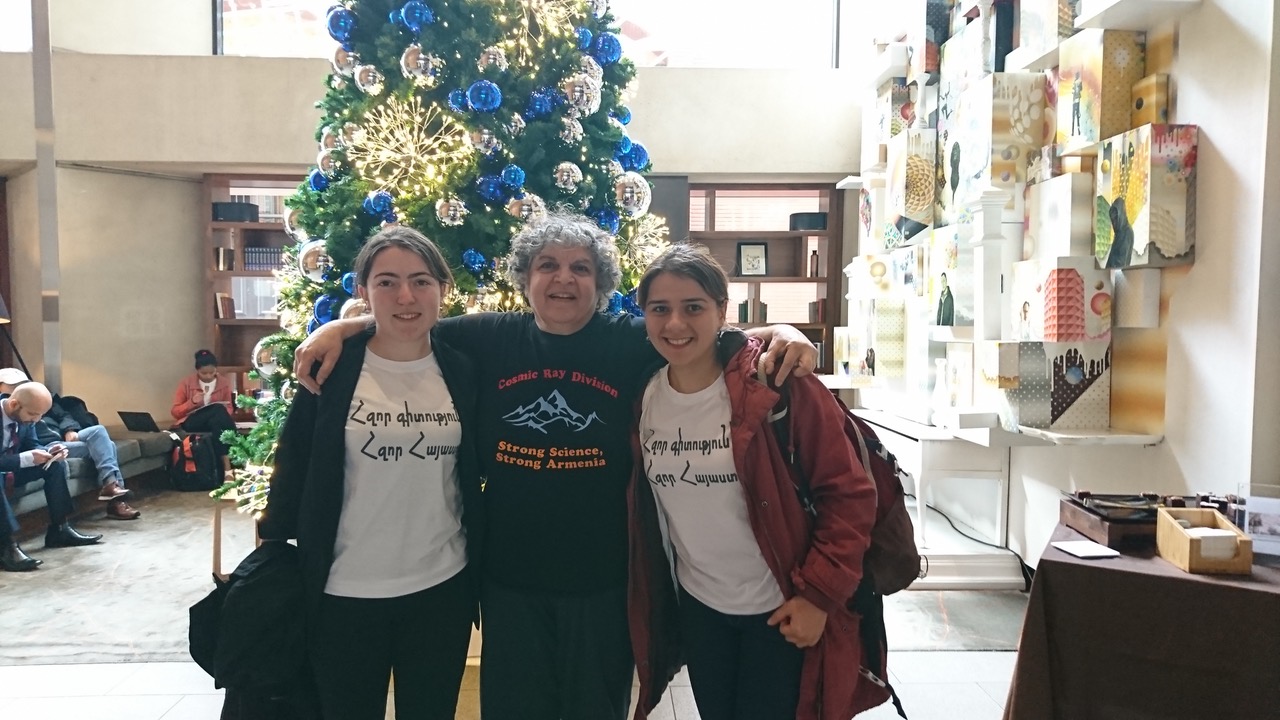
Five scientists, engineers and students from Armenia’s Cosmic Ray Division (CRD), Yerevan Physics Institute, with 4,000 other scientists, participated in the American Geophysical Union (AGU) Congress from December 9 to 13, 2019 in San Francisco. Presenting different aspects of CRD’s research were Prof. Ashot Chilingarian, CRD’s head; Balabek Sargsyan, engineer; and three young scientists: Dr. Hripsime Mkrtchyan, physicist; Gayane Karapetyan, physicist and student; and Davit Aslanyan, undergraduate student.
The interviews were conducted via email with Hripsime, Gayane and Davit by longtime Weekly contributor Joseph Dagdigian. They have been edited for length and slightly edited for clarification.
Joseph Dagdigian: Please introduce yourselves and tell us about your background, where you grew up, and your education.
Hripsime Mkrtchyan: I was born in Yerevan. I did not dream of becoming a scientist or doing physics. I didn’t even know what a scientist was. But now I can definitely say that I couldn’t have chosen anything better for myself. I really love my profession and enjoy doing the research. I graduated from the Physics Department of Yerevan State University last summer and received my PhD at the Alikhanyan National Science Laboratory (CRD) in Atmospheric Physics.

Gayane Karapetyan: I was born in the village Tsaghkunq, near Lake Sevan. I went to school in the village. Since then I have been fond of mathematics and physics. I wrote my research work for my diploma at the Yerevan Physics Institute with Hripsime Mkrtchyan, and defended it at Yerevan State University. I earned my bachelor’s degree in 2019.
Davit Aslanyan: I was born in Yerevan. From a young age my parents noticed my inclination towards science and guided me to apply to the Shahinyan Physical-Mathematical Specialized School. I am an undergraduate student majoring in Physics at the Yerevan State University and a trainee physicist at the CRD.
J.D.: How did you get interested in science? What brought you to the CRD?
H.M.: Honestly, the way for choosing a specialty in Armenia is not developed. Nobody at school advises you what opportunities you have. If you like biology, chemistry or physics you will choose them; if you do not you will never know which opportunities you are missing.
As a programmer, it seemed very boring and without invention or creativity. I met Prof. Chilingarian, and he gave me the belief that everyone can make discoveries by becoming good specialists. I started working at CRD in 2011. My research is devoted to thundercloud electric structure investigations. The topic of my PhD dissertation was “The Behavior of the Electric Field During Fair Weather and Thunderstorms.”
G.K.: Last year at school I wanted to become a programmer, but one of my teachers told me very interesting facts about science and the faculty of physics. I changed my mind and now I’m glad that I chose science. In the first year of my studies, I was a little disappointed because I wanted to learn more about real, modern science. A friend suggested I attend open seminars at the Yerevan Physics Institute. I met Hripsime Mkrtchyan; she took me to CRD and told me about her work, which was very interesting.
D.A.: Lightning flashes have fascinated me from a very young age. I initially got interested in Atmospheric Physics when I met Hripsime in 2017. I was hoping that exploring Atmospheric Physics would help me understand how lightning and thunderstorms originate.
J.D.: How long have you been associated with the CRD? What are your responsibilities there?
D.A.: I joined CRD in Summer, 2018 and started working at CRD in 2019. I am a trainee physicist and my research is devoted to thunderstorm ground enhancement investigations.
G.K.: I joined CRD in 2017, and in 2018 I started working there. I am doing research on thundercloud electric structure investigations and now I am applying ANI (a CRD developed complex of machine learning algorithms) for classification of lightning types.
Joseph to Gayane and Davit: You are both continuing your education. Where are you in this process?
G.K.: I am a masters student at the Yerevan State University Astrophysics Department. After this step, I want to apply for a PhD program at CRD.
D.A.: I am a senior at Yerevan State University, and will get my Bachelors diploma in July. My major area of study is Nuclear and Elementary Particle Physics. I plan to continue my education at the Cosmic Ray Division.
J.D.: In 2019 you each attended the international Thunderstorms and Elementary Particle Acceleration (TEPA) conference at Nor Ambert in Armenia. What was your participation there and your impressions?
H.M.: Many leading scientists from around the world have visited Nor Amberd during TEPA conferences. It is always a pleasure to discuss science at the Nor Amberd research station. From 2013-2015 I was involved in coordination of the TEPA conference.
G.K.: Attending TEPA was a very good experience for me. I presented a talk on “Atmospheric Discharge Classification with Machine Learning Algorithms.”
D.A.: Attending the TEPA conference in 2019 was an eye-opening experience for me as an undergraduate student. TEPA was my first opportunity to interact with fellow scientists from outside Armenia in a formal setting. I presented a talk at the 2019 meeting.
J.D.: Can you briefly tell us about the international scientific forums you have participated in and your current area of research?
H.M.: Now I am a member of different organizations and am getting invitations to participate in different activities and represent Armenia and my research. I think scientific conferences are also type of culture representation. In December with Davit and Gayane I participated in AGU 2019 where we were invited to participate in panel discussions devoted to the future of science. I also had an oral presentation of work which I did with Prof. Chilingarian and my advisor Prof. Williams from MIT.
J.D.: What other interests do you have? I know that some of you are involved in the “Young Minds” project mentoring high-school students in Armenia and Artsakh.
H.M.: Yes, we are members of Yerevan Young Minds. We are continuing to teach and show the beauty of science at schools. We are looking for funding to start new public activities for making science fun for those who are reluctant to become scientists.
G.K.: I am a member of Yerevan Young minds project and SPIE (International Society for Photonics and Optics), Yerevan State University chapter. We are doing a lot of outreach events in Yerevan, Artsakh and other regions of Armenia.
J.D.: What are your ambitions or goals for the future?
H.M.: I dream of creating an applied atmospheric laboratory in Armenia, using atmospheric science for solving water problems on the borders of Armenia, cleaning the environment and protecting nature from hazardous phenomena. I hope to establish it in the near future, but it is very difficult to start such things, as the government really doesn’t understand the need to invest into science.
G.K.: I will continue studying physics, and I will try to understand lightning phenomena.
D.A.: I hope to become a researcher and lead a laboratory where we will test various cloud radiation models and uncover the mystery of lightning initiation.

JD: What are your impressions of the AGU conference and your visit to San Francisco? Have you met members of the local Armenian community?
D.A.: AGU Fall Meeting was [a] very big conference with enormous opportunities to connect with scientists from around the globe and participate in various workshops.
H.M.: The meeting was big. We even organized a very nice dinner at Anahid’s home and discussed the ways for collaborations. (Anahid Yeremian is the Chairperson of Support Committee for Armenia’s Cosmic Ray Division – SCACRD). My heart is always getting warmer when I meet Armenians outside our country who are worried about our homeland and want to do something, even from a long distance. It makes you feel very strong, able to make changes and make your country better.

J.D.: The Diaspora here has shown a great deal of interest in Armenian science and particularly the Cosmic Ray Division. What message would you like to send to the Armenian community here?
H.M.: First of all, I would like to thank everyone for all the help and encouragement which we continue getting from [the] Armenian Diaspora. With their help we have obtained needed instrumentation which gives us the opportunity to investigate different physical phenomena. It puts Armenia in many international scientific collaborations and opens new opportunities.
G.K.: I would like to thank the diaspora for their help, especially for the excellent opportunity to participate in the AGU. I really hope that Armenian scientists from abroad will visit us often and share their experience with the younger generation.



Be the first to comment